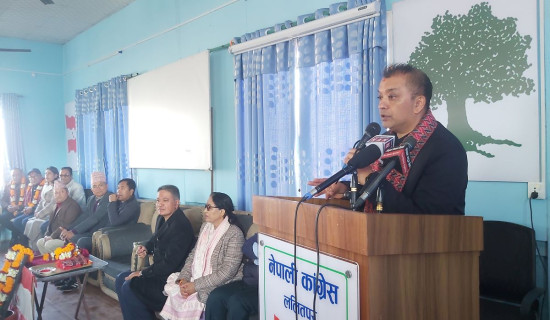- Monday, 15 December 2025
Concrete Efforts Needed For Air Safety
Nepal has been portrayed globally in a negative light once again owing to the crash of a 72-seater ATR aircraft belonging to Yeti Airlines. The ill-fated plane crashed into the Seti River gorge near the old domestic airport in Pokhara at 10:50 am on January 15. With 68 passengers and four crew members, the aircraft was flying to Pokhara from Kathmandu. With its call sign 9N-ANC, the NYT 691 aircraft went down as it was approaching the newly-built Pokhara International Airport for landing. Fifty-three Nepalis, five Indians, four Russians, two South Koreans, and one each from Ireland, Australia, France and Argentina were among those killed in the accident. The bodies of 71 people on board the flight the ‘Black Box’ have already been recovered. Search teams have kept on making their all-out efforts to retrieve the remaining body. The process of handing over the bodies to their respective family members is still going on.
Worst disaster
This was the worst aviation disaster involving a domestic flight in the country’s more than seven-decade long aviation history. Generally, inconsistent weather conditions are regarded as the main cause of air accidents in the country. But weather was not responsible for the plane crash this time. The sky was quite clear and everything was visible. However, no Instrument Landing System (ILS) has so far been installed at the Pokhara International Airport that was thrown open only on January 1 this year.
The unfortunate ATR 72 aircraft was flown by senior instructor pilot Kamal KC accompanied by co-pilot Anju Khatiwada. Captain KC is reported to be guiding Anju for landing the aircraft at the new airport. What is notable is that Anju had got her pilot training with the money she received from the insurance following her husband’s death. Her husband was a pilot working with Yeti Airlines itself. He had lost his life in a Twin Otter crash in Jumla in 2006. The fresh ATR plane crash is regarded as the most catastrophic after a Pakistan International Airlines plane accident at Bhattedanda of Lalitpur in 1992. All 167 people aboard the flight had been killed in the crash. The plane was attempting to land at Kathmandu.
However, no sooner had the ATR aircraft crashed than the government formed a five-member probe commission that has been mandated to submit its report to the Ministry of Culture, Tourism and Civil Aviation (MoCTCA) within 45 days. As the probe panel that includes aviation experts has initiated the process of investigation immediately after the incident, it may find out the truth behind such a horrible air crash soon.
Airlines from around the globe have been found using the ATR 72 category aircraft to operate shirt regional flights over the past 30-35 years. This type of aircraft has been introduced a French and Italian partnership. The planes of this model have met deadly crashes in different countries worldwide. In May last year too, a Twin Otter of Tara Air had met with an accident in Mustang, killing all 22 persons on board the flight. The aircraft had been flying to Jomsom from Pokhara. An unfavourable weather condition was blamed for
the crash.
Difficult topography, unpredictable weather, human errors, technical problems and bird hits, among others, are the major factors leading to air accidents in the country. There is no doubt that the repeated plane crashes have tainted Nepal’s reputation as an important tourist destination worldwide. The international media has highlighted the horrible plane crash, depicting the Nepali sky as unsafe.
Air service is considered to be the safest means of transportation globally. But it is sad to mention that Nepal has recorded constant air crashes since the beginning. The nation’s tourism industry has suffered a setback because of recurrent air crashes. With such accidents, there is a general perception among foreigners and Nepalis alike that Nepali carriers are not safe to fly. The country has witnessed as many as fatal 17 air crashes over the last 23 years. Some 350 persons have been killed in plane and helicopter crashes in the country since 2000. The database maintained by the Flight Safety Foundation’s Aviation Safety shows that 42 fatal plane crashes have occurred in the country since 1946. However, such incidents can occur in other parts of the world as well.
EU's ban
Showing poor air safety standards in Nepal, the European Union (EU) has put a ban on Nepali carriers from flying into the 27-nation bloc since December 2013. As Europe is an important tourist source market for Nepal, the prohibition on the nation's airlines has dealt a severe blow to our tourism. Following the EU's step, Nepal has come a long way when it comes to aviation safety. However, much still remains to be dome to make sure that the nation's aviation safety is on par with global standard. The Nepal government has been trying to take the EU into confidence by making drastic improvements in the aviation sector. But the continuous air crashes in the country have still questioned the air safety. But, recognising the aviation reforms made by Nepal, the International Civil Aviation Organisation (ICAO) lifted its ban in 2017.
Despite all this, Nepal must focus on reforming the aviation sector to ensure air safety. The government, the Civil Aviation Authority of Nepal (CAAN) and airlines must make every possible effort to revamp the aviation sector. Many probe commissions have submitted their detailed reports along with specific recommendations to the government. But such reports seem to have been gathering dust. They hardy have been implemented. This situation must end. When concrete measures are taken, the air safety situation is sure to get improved in no time. This will definitely instil a lot of confidence among travellers, which in turn may help boost our tourism industry.
(Dahal is a deputy executive editor of this daily.)
















